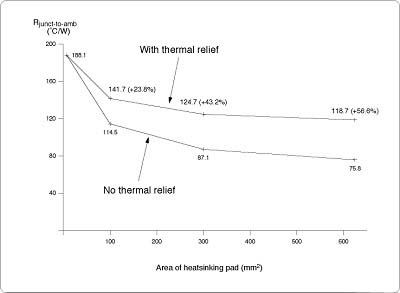|
About thermal relief
The term "thermal relief" describes circuit board modifications
made to impede heat flow from copper pads during soldering. As shown
in Figure 1, thermal relief involves creating a break in the copper,
sometimes referred to as a "thermal moat" or a "thermal dam". The thermal
relief makes it easier to heat a pad for reflow soldering since there is
less heat loss to adjacent pads. However, there is
an impact on components, such as SOT-223 package devices, which use the
circuit board to dissipate heat.

Figure 1: Typical thermal relief configuration for SOT-223 package
Using Sauna to evaluate thermal relief configurations
The Sauna program provides the necessary tools to quickly and
accurately model a thermal relief configuration. To model the
geometry shown in Figure 1, the first step is to define the pads.
Since the SOT-223 is one of the many standard packages in Sauna's
library, these pads can be quickly created. As part of this process,
you would specify the size of the heatsinking pad (10 mm x 10 mm in
the picture) and the trace width and length.
Next, you would use Sauna's tools for editing copper traces to create
the "moat" and "drawbridge" shown in the picture. This is a
straightforward process.
When the copper pattern has been defined, you would add the SOT-223
device. The device is represented with an "enhanced heat source" in
Sauna. The enhanced heat source includes a thermal connection between the
junction and each lead pad. There is also heat transfer from the top
of the component body to the room, and another thermal path down into
the circuit board. With an enhanced source, the simulation will
incorporate heat flow from all surfaces of the package.
If the analysis only focuses on heat flow through the tab, the
negative impact of the thermal relief will be overstated.
After adding the component, you would complete the model by adding
float resistors to the room environment. You can calculate temperatures
for either natural or forced air cooling. The entire model shown in
Figure 1 can be created and analyzed in minutes.
A multi-configuration study for the SOT-223 device
With Sauna you can quickly evaluate a series of design alternatives.
For a SOT-223 device, Sauna models were created for a series of
heatsinking pad sizes: 3.5 mm x 2 mm (7 mm²), 10 x 10 (100
mm²), 17.3 x 17.3 (300 mm²) and 25 x 25 (625 mm²/1
inch²). The models were first analyzed without
thermal relief. Then thermal relief was added and temperatures
recalculated. The results of these analyses are shown in Figure 2:

Figure 2: Impact of adding thermal relief
The graph shows interesting results.
For the small pad of 100 mm² (0.16 in²), the impact of
thermal relief is fairly modest. The junction-to-ambient thermal
resistance (Rja) does increase by 23.8% relative to the no
thermal relief case. However, the 100 mm² pad still provides a
clear benefit when compared with the minimal 7 mm² pad, as
Rja decreases from 188.1°C/W to 141.7°C/W. For larger
pads, the negative impact is significantly greater. With the 300
mm² (0.47 in²) pad, thermal relief causes an Rja
increase of 43.2%. For a 625 mm² (1 in²); pad, the
increase is 56.6%.
Also, the graph shows that thermal relief greatly limits the benefit of
using a large heatsinking pad. When thermal relief is present, an
increase in pad size from 100 mm² to 625 mm² only reduces
Rja by 16.2% (reduced from 141.7°C/W to 118.7°C/W).
The impact is even more dramatic when comparing with
and without thermal relief. The Rja for a 100 mm²
pad without thermal relief (114.5°C/W) is largely identical to
the Rja for a 625 mm² pad with thermal relief
included (118.7°C/W). Thermal relief can have a substantial
negative impact for some situations.
To read the full study,
see
Impact Of Thermal Relief On The Cooling Of A SOT-223 Device.
The next step
The best way to learn about the Sauna program is to try the free
evaluation package. You can request the evaluation package
here.
If you want additional information on Sauna features, try one of
these links:
|